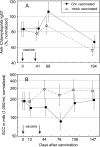Therapeutic Chlamydophila abortus and C. pecorum vaccination transiently reduces bovine mastitis associated with Chlamydophila infection
- PMID: 17118976
- PMCID: PMC1828509
- DOI: 10.1128/IAI.00691-06
Therapeutic Chlamydophila abortus and C. pecorum vaccination transiently reduces bovine mastitis associated with Chlamydophila infection
Abstract
Infections with Chlamydophila abortus and C. pecorum are highly prevalent in cattle and have been associated with bovine mastitis. A prospective cohort study was conducted with a herd of 140 Holstein dairy cows to investigate the influence of Chlamydophila infection on subclinical inflammation of the bovine mammary gland as characterized by somatic cell numbers in milk. PCR detection of C. abortus and low serum antibody levels against Chlamydophila spp. were significantly associated with subclinical mastitis. To examine the effect of the infection by response modification, immune perturbation was done by two subcutaneous administrations of an experimental vaccine preparation of inactivated C. abortus and C. pecorum elementary bodies. Vaccination against Chlamydophila highly significantly decreased milk somatic cell numbers, thus reducing bovine mastitis, and increased antibody levels against Chlamydophila but did not eliminate shedding of C. abortus in milk as detected by PCR. The protective effect peaked at 11 weeks after vaccination and lasted for a total of 14 weeks. Vaccination with the Chlamydophila vaccine, a mock vaccine, or a combination vaccine against bovine viral diseases highly significantly increased C. abortus shedding in milk for 1 week, presumably mediated by the vaccine adjuvant. In summary, this study shows an etiological involvement of the widespread Chlamydophila infections in bovine mastitis, a herd disease of critical importance for the dairy industry. Furthermore, this investigation shows the potential for temporary improvement of chlamydial disease by therapeutic vaccination. Chlamydophila vaccination of cattle might serve as a testing ground for vaccines against human chlamydial infections.
Figures





References
-
- Bowen, R. A., P. Spears, J. Storz, and G. E. Seidel, Jr. 1978. Mechanisms of infertility in genital tract infections due to Chlamydia psittaci transmitted through contaminated semen. J. Infect. Dis. 138:95-98. - PubMed
-
- Caro, Maria, R., N. Ortega, A. J. Buendia, M. C. Gallego, L. D. Rio, F. Cuello, and J. Salinas. 2003. Relationship between the immune response and protection conferred by new designed inactivated vaccines against ovine enzootic abortion in a mouse model. Vaccine 21:3126-3136. - PubMed
-
- Cavirani, S., C. S. Cabassi, G. Donofrio, B. De Iaco, S. Taddei, and C. F. Flammini. 2001. Association between Chlamydia psittaci seropositivity and abortion in Italian dairy cows. Prev. Vet. Med. 50:145-151. - PubMed
-
- Christiansen, G., and S. Birkelund. 2002. Is a Chlamydia vaccine a reality? Best. Pract. Res. Clin. Obstet. Gynecol. 16:889-900. - PubMed
Publication types
MeSH terms
Substances
Grants and funding
LinkOut - more resources
Full Text Sources
Other Literature Sources
Miscellaneous

